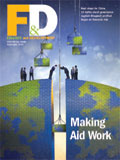 About F&D Subscribe Back Issues Write Us Copyright Information Tanzania and the IMF Free Email Notification Receive emails when we post new
items of interest to you. |
Tanzania: 'Smart' Partnerships Over the past decade, Tanzania has achieved commendable progress in economic development and in restoring macroeconomic stability from the crisis situation that prevailed in the early 1990s. Real economic growth averaged 5 percent per year during 1995–2003 and 6 percent during 2002–04, well above the average growth of less than 2 percent during the preceding decade. Inflation has been low and stable, averaging 4 percent since 2000, sharply down from more than 30 percent in the mid-1990s. Official international reserves have improved to over 8 months of imports of goods and services from less than 2 months in the early 1990s. Nevertheless, with almost 36 percent of the population living below the national basic needs poverty line, Tanzania still has a long way to go to achieve the MDGs. It will need to maintain high growth, low inflation, and a steady pace of structural reforms for many years. Aid will play a crucial role by complementing domestic resource mobilization and capacity building. It now finances over 40 percent of budgetary spending, up from some 20 percent a decade earlier. With aid inflows to Tanzania expected to rise to 12 percent of GDP in 2005/06 from around 9 percent in 2003/04, it is essential that aid flows remain predictable and do not fluctuate too much. Conditions for effective aid Tanzania’s experience has shown that, in order for a country to be able to effectively absorb and utilize aid, certain minimum conditions have to be in place. They include a clear national development vision upon which donor support can be anchored, coupled with an appropriate medium-term strategy for achieving it, strong government leadership and national ownership of the development process, and sustained reforms, including in aid delivery. Also critical are sound public expenditure and financial management systems, trust between the government and overseas development partners, and promotion of democracy and good governance. Since the mid 1990s, Tanzania has taken the lead in designing and managing the development process. It has adopted a clearly articulated national development vision formulated through a broad participatory process in a national Poverty Reduction Strategy in 2000, followed in 2004 by the National Strategy for Growth and Reduction of Poverty (NSGRP), known by its Kiswahili acronym MKUKUTA. The focus of this second generation strategy is on three areas: growth and reduction of poverty, improved quality of life and social well being, and good governance and accountability. We aim to achieve these goals by strengthening agriculture and rural development, boosting private sector development and export diversification, encouraging effective participation of civil society, and enhancing country ownership and leadership as well as "smart" partnerships with donors. The government has also bolstered domestic accountability by improving public financial management systems and the national budget process, which in turn, has enabled donors to rely increasingly on government systems and processes in delivering aid. To support its development strategy, Tanzania has implemented a range of macroeconomic policy measures that have yielded a more streamlined tax system and an efficient tax administration—triggering tangible revenue results—and transformed a problem-ridden financial sector into a modern, sound financial system. The government has also taken steps to provide an enabling environment for private sector development—including direct foreign investment—through restructuring and privatizating public enterprises, and improving the legal and regulatory framework. As a result, development partners have shown a greater willingness to better coordinate and harmonize their support and align it with national priorities and government systems and procedures. They have also been more willing to channel aid through general budget support, which has helped substantially increase the predictability of aid, as funding commitments are decided prior to the year in which disbursements are to be made. Aid disbursement is now more fully integrated into the national budget process. Is there a risk of becoming too reliant on aid? This can occur when aid is not effectively used for development and capacity-building objectives that foster long-term self-reliance, and when aid is not aligned with national priorities and capacity needs. In Tanzania, aid management is part and parcel of our ongoing economic reform program. Aid is targeted at developing infrastructure and human resources, improving governance, and promoting private sector investment. This approach will enable us to gradually graduate from aid dependency. |